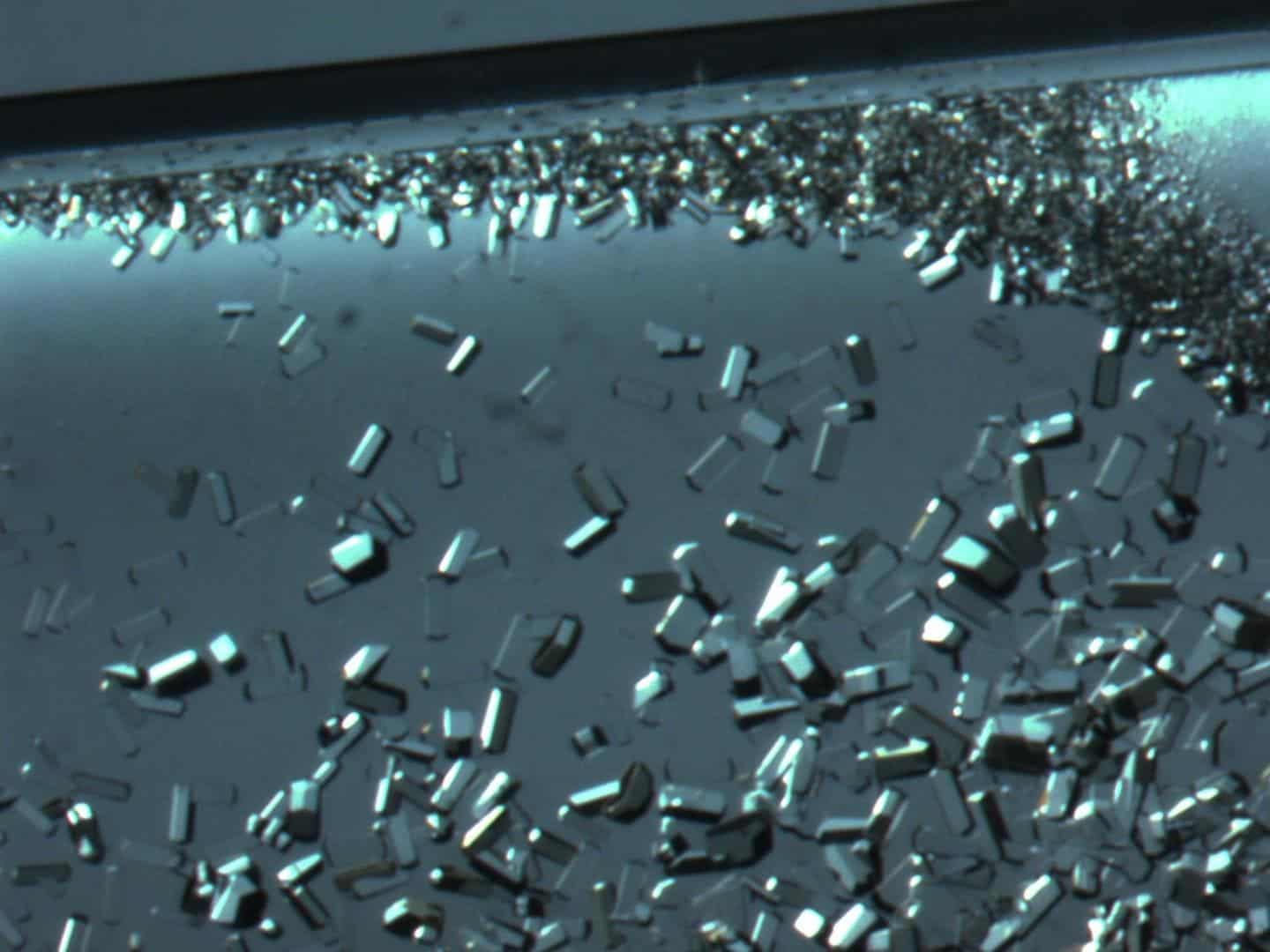The Potential Of Orbital Space Crystals In Drug Research

Table of Contents
Superior Crystal Growth in Microgravity
The microgravity environment of space offers unparalleled advantages for crystal growth, leading to superior crystal quality compared to Earth-based methods. This improvement stems primarily from the absence of convection currents, a significant factor affecting crystal formation on Earth.
Minimizing Defects
Convection currents, caused by variations in temperature and density, can disrupt the orderly growth of crystals, leading to imperfections and defects. In the microgravity of space, these disturbances are minimized, resulting in larger, more perfect crystals with significantly fewer defects.
- Improved crystal purity: Reduced impurities lead to more reliable and reproducible experimental results.
- Enhanced structural analysis: Defect-free crystals provide clearer and more accurate data for structural analysis techniques like X-ray diffraction.
- More consistent drug potency: Crystals with fewer defects ensure more consistent drug potency and bioavailability, leading to improved therapeutic efficacy.
The impact of crystal defects on drug efficacy is substantial. Defects can alter the crystal lattice structure, affecting drug solubility, stability, and even its interaction with target molecules. Defect-free crystals grown in space offer a significant advantage for both research and development, leading to more reliable and potent pharmaceuticals.
Growing Larger Crystals
Microgravity also allows for the growth of significantly larger crystals than is typically possible on Earth. This is because the absence of sedimentation and buoyancy forces allows for more uniform solute distribution around the growing crystal.
- Increased yield: Larger crystals translate directly into higher yields of purified material.
- Reduced production costs (in the long term): While the initial investment in space-based crystal growth is high, the increased yield and improved purity could lead to lower production costs in the long run.
- Easier handling and processing: Larger crystals are easier to handle and process, simplifying downstream purification and formulation steps.
Examples of crystals relevant to drug research that benefit from space-grown methods include proteins crucial for understanding disease mechanisms and developing targeted therapies, as well as inorganic crystals used in drug delivery systems.
Applications in Drug Discovery and Development
The superior quality of orbital space crystals opens up numerous applications in drug discovery and development, accelerating the process and potentially leading to more effective treatments.
Protein Crystallography
Protein crystallography is a vital technique for determining the 3D structure of proteins, essential for understanding their function and designing targeted drugs. Space-grown protein crystals often exhibit superior diffraction quality, leading to higher-resolution structures.
- Improved resolution: Higher resolution structures reveal finer details of protein conformation, crucial for drug design.
- Easier structure determination: Improved crystal quality simplifies the structure determination process, potentially accelerating drug development timelines.
- Faster drug development: A better understanding of protein structure facilitates the design of more effective and targeted drugs.
This application is particularly impactful in areas such as cancer research, where understanding the structure of oncoproteins is crucial for developing targeted therapies, and in Alzheimer's research, where unraveling the structure of amyloid plaques is key to developing disease-modifying drugs.
Formulation and Delivery
Space-grown crystals may also lead to improvements in drug formulation and delivery systems. The precise control over crystal size and morphology in microgravity could enable the creation of novel drug delivery mechanisms.
- Enhanced bioavailability: Improved crystal properties can lead to enhanced drug absorption and bioavailability.
- Targeted drug delivery: Space-grown crystals might enable the development of targeted drug delivery systems, reducing side effects and improving efficacy.
- Improved patient compliance: Controlled-release systems using space-grown crystals could improve patient compliance by simplifying dosage regimens.
For instance, the development of controlled-release systems based on space-grown crystals could revolutionize the treatment of chronic diseases, requiring less frequent administration and improving patient adherence to medication.
Materials Science Advancements for Drug Production
The unique conditions of space can lead to the creation of novel materials and improved processes for drug manufacturing. This opens up possibilities for new drug synthesis methods and more efficient production processes.
- Improved reactor designs: Microgravity can influence reaction kinetics, potentially leading to improved reactor designs for drug synthesis.
- New drug synthesis methods: The unique conditions of space could enable the discovery of novel drug synthesis methods, leading to new drug candidates.
- More efficient production processes: Improved crystal quality and larger crystal size could lead to more efficient purification and formulation processes.
Examples of materials that could benefit from space-based production include specialized polymers used in drug delivery systems or advanced catalysts that improve the efficiency of drug synthesis reactions.
Conclusion
The use of orbital space crystals represents a significant leap forward in drug research. By mitigating the limitations of Earth-based crystal growth, the unique microgravity environment allows for the production of higher-quality crystals with fewer defects, enabling breakthroughs in protein crystallography, drug formulation, and materials science. This has profound implications for the development of novel pharmaceuticals and improved therapies for a wide range of diseases. Further research and investment in this area are crucial to fully unlock the transformative potential of orbital space crystals and accelerate the pace of drug discovery. Let's continue to explore the possibilities of using space-grown crystals to revolutionize the pharmaceutical industry and improve global health.

Featured Posts
-
 Andrew Flintoff Documentary Premieres On Disney This Month
May 23, 2025
Andrew Flintoff Documentary Premieres On Disney This Month
May 23, 2025 -
 Pryamaya Translyatsiya Tennisnogo Matcha Rybakinoy Za 4 Milliarda Dollarov
May 23, 2025
Pryamaya Translyatsiya Tennisnogo Matcha Rybakinoy Za 4 Milliarda Dollarov
May 23, 2025 -
 Jasprit Bumrah Top Ranked Test Bowler In Icc Rankings
May 23, 2025
Jasprit Bumrah Top Ranked Test Bowler In Icc Rankings
May 23, 2025 -
 Istoriya Uspekha Kazakhstan V Finale Kubka Billi Dzhin King V Tretiy Raz
May 23, 2025
Istoriya Uspekha Kazakhstan V Finale Kubka Billi Dzhin King V Tretiy Raz
May 23, 2025 -
 Smart Appliance Buys Memorial Day Sales 2025 Forbes Vetted
May 23, 2025
Smart Appliance Buys Memorial Day Sales 2025 Forbes Vetted
May 23, 2025
Latest Posts
-
 A Couples Argument Joe Jonass Response A Funny Story
May 23, 2025
A Couples Argument Joe Jonass Response A Funny Story
May 23, 2025 -
 Joe Jonas Responds To Married Couples Dispute
May 23, 2025
Joe Jonas Responds To Married Couples Dispute
May 23, 2025 -
 The Jonas Brothers Response To A Fight Over Him
May 23, 2025
The Jonas Brothers Response To A Fight Over Him
May 23, 2025 -
 Joe Jonass Hilarious Response To Couples Fight Over Him
May 23, 2025
Joe Jonass Hilarious Response To Couples Fight Over Him
May 23, 2025 -
 Couple Fights Over Joe Jonas His Hilarious Response
May 23, 2025
Couple Fights Over Joe Jonas His Hilarious Response
May 23, 2025
